Greening Mine Action in Armenia
as a Component of Sustainable Development in the Economy of the Country
CISR JournalThis article is brought to you by the Center for International Stabilization and Recovery (CISR) from issue 28.3 of The Journal of Conventional Weapons Destruction available on the JMU Scholarly Commons and Issuu.com.
By Vaghinak Sargsyan [ Center for Humanitarian Demining and Expertise ]
Contamination in Armenia stems from the long-term conflict with Azerbaijan, affecting four out of eleven regions in Armenia: Tavoush region, Syunik region, Gexarquniq region, and Vayots Dzor region. The contamination covers an area of more than 42 km2, with more than 10 km2 confirmed hazardous areas and over 31 km2 suspected hazardous areas. Land affected includes pasture (66 percent), arable (22 percent), and forest (12 percent). There are 805 registered victims of landmine and explosive remnants of war (ERW) incidents.
Additionally, among the 120,000 displaced Karabakh Armenians, more than 700 are survivors of landmines and ERW, many of whom find themselves in a socially vulnerable position.
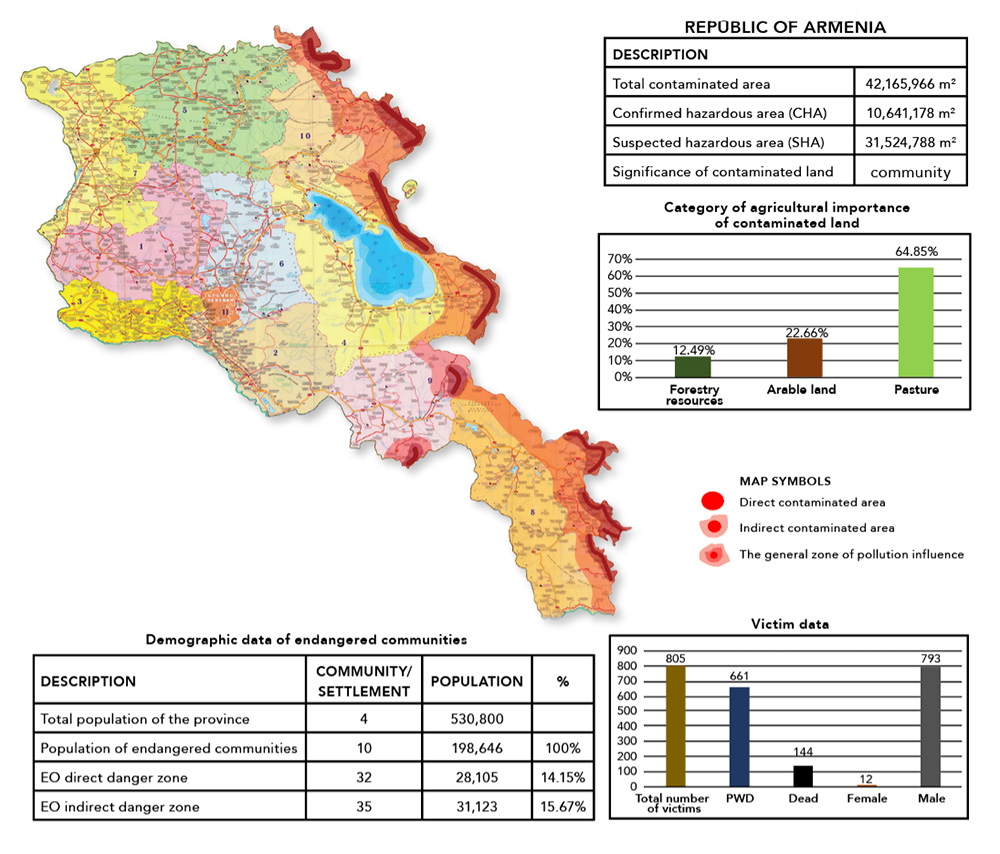
Consequences of Landmine and Explosive Remnants of War Contamination
Areas contaminated with anti-personnel and anti-tank mines, cluster munitions, and other remnants of war present a threat to the residents of Armenia, impeding free movement, development of infrastructure, and the cultivation of land; endangering residents’ safety; and the implementation of various social and economic programs in affected areas. This causes a chain reaction disrupting the sustainable development of the Armenian economy.
ERW have left thousands of people in Armenia with physical and psychosocial disabilities. Some survivors’ inability to work due to their physical injuries can lead to psychological issues. Adopted in 2021, the Law on the Rights of Persons with Disabilities1 aims to protect people with disabilities from discrimination and provide more inclusive opportunities, guaranteeing accessibility, independent living, access to justice, and reasonable accommodations.
Mine action is an important activity for any country with contaminated areas. It is imperative to increase the efficiency of such work, organize clearance and land release activities in a short time frame, set targeted priorities for the areas to be cleared, raise awareness among the population and promote behavioral change, carry out interconnected activities for targeted and coordinated victim assistance, and facilitate the implementation of various socioeconomic programs enabled by the clearance process.
Mine action cannot exclusively be a professional function in narrow terms, operating on the principle of “clearance for clearance’s sake.” It should function within the context of socioeconomic programs implemented by the state, local self-governing authorities, and international institutions.
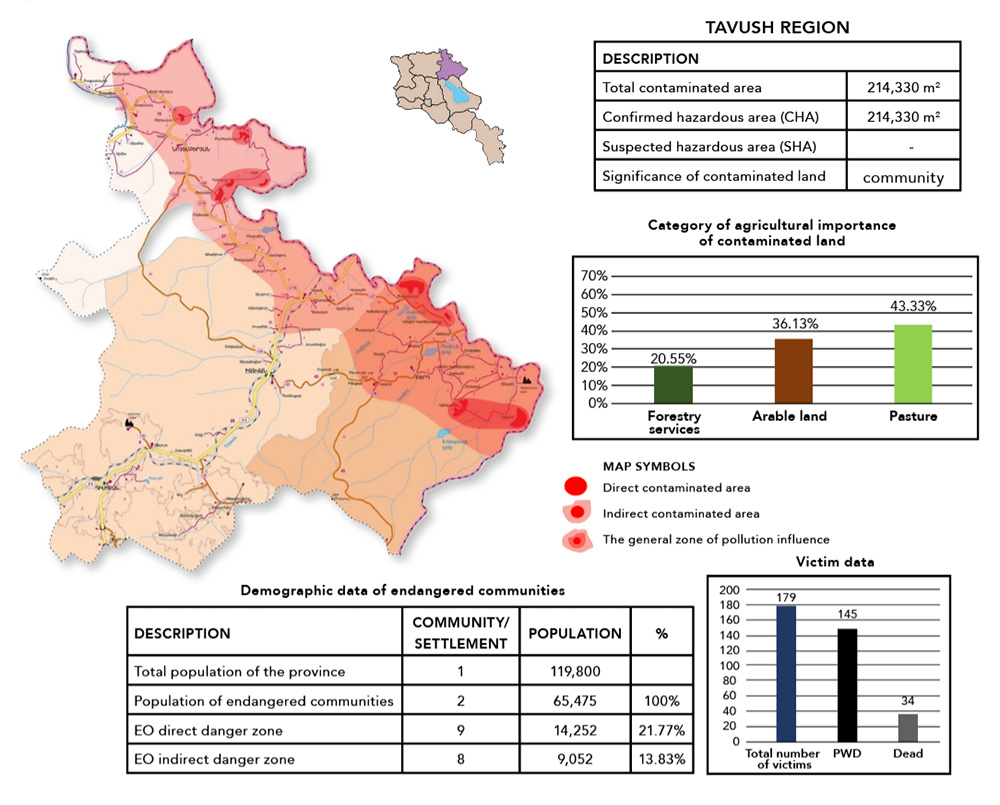
The Center for Humanitarian Demining and Expertise
Since 2023, Armenia’s Center for Humanitarian Demining and Expertise (CHDE) has conducted research on the aforementioned issues in cooperation with the UN Development Programme, World Food Programme, and UNICEF. Several pilot projects were jointly developed and implemented, aiming to find the optimal solutions to these issues. Currently, the mine action sector in Armenia works within a complex but innovative landscape. It is not only about what we do, but also how we and our partners translate the results of our joint work into long-term socioeconomic and environmental benefits for affected people and communities.
These include a wide range of operations within the context of mine action, including cooperation with public institutions, the private sector, international entities, and local and international nongovernmental organizations; setting priorities; collecting and managing data; conducting clearance operations; developing risk education to encourage behavioral change; victim assistance and involving survivors in the risk education process; environmental protection; and the application of artificial intelligence in analysis and planning activities. The process forms a roadmap that can help mitigate the problems caused by landmine and ERW contamination.
Within the scope of these programs, the CHDE coordinates with local self-governing authorities of contaminated regions, as well as with local and international organizations. During this coordinated work, certain activities are carried out in the prioritized communities (and in time, in all affected communities) thanks to complex cost-benefit planning. These activities include the survey, clearance, and handover of formerly-contaminated areas to local communities, development and implementation of socioeconomic programs, and monitoring and analysis of overall mine action activities, including residual risks.
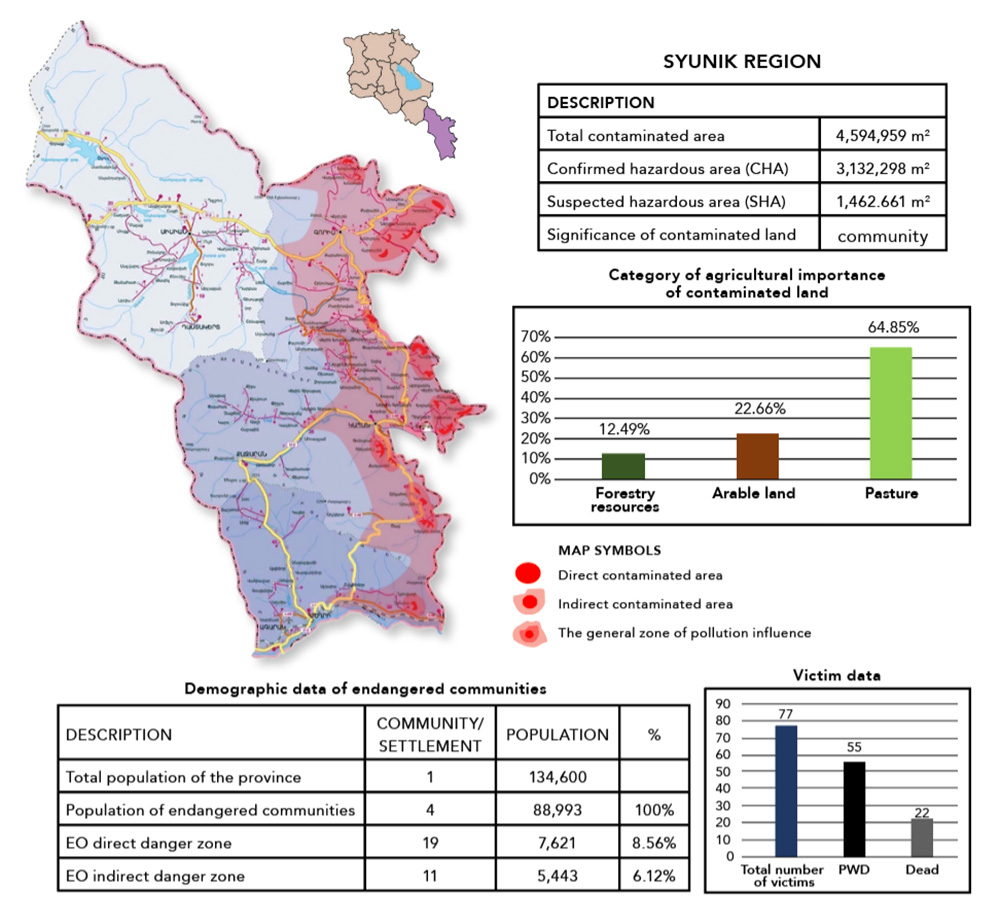
Greening Mine Action
With this approach, where Greening Mine Action equates to safety and development, the CHDE prioritizes defining the landmine and ERW problem not only in terms of the number of affected communities or the size of contaminated areas, but also within the larger impact of explosive contamination on people and communities. The CHDE emphasizes the importance of social, economic, behavioral, and environmental impacts on people and communities in the context of sustainable development, land release, and environmental protection. This transformation not only leads to major improvements in the quality of mine action, but also facilitates the integration of mine action within the broader field of post-conflict recovery and development. Greening Mine Action encompasses three distinct stages.
Stage 1: Design a Monitoring System of Contaminated Areas
Stage one consists of the short- and long-term monitoring of contaminated areas, known as pre- and post-clearance. Confirmed hazardous areas are cleared by both technical survey and land release activities, and explosive ordnance risk education (EORE) is conducted among the local population. EORE is conducted in person, particularly for schoolchildren and community members living in affected regions. With support from the UNDP, summer camps were organized in 2022 and 2023, attended by sixty families of mine/EO victims. In 2024, in cooperation with UNICEF and the Ministry of Education, Science, Culture, and Sports, EORE was introduced into school curricula, reaching 1,670 people.
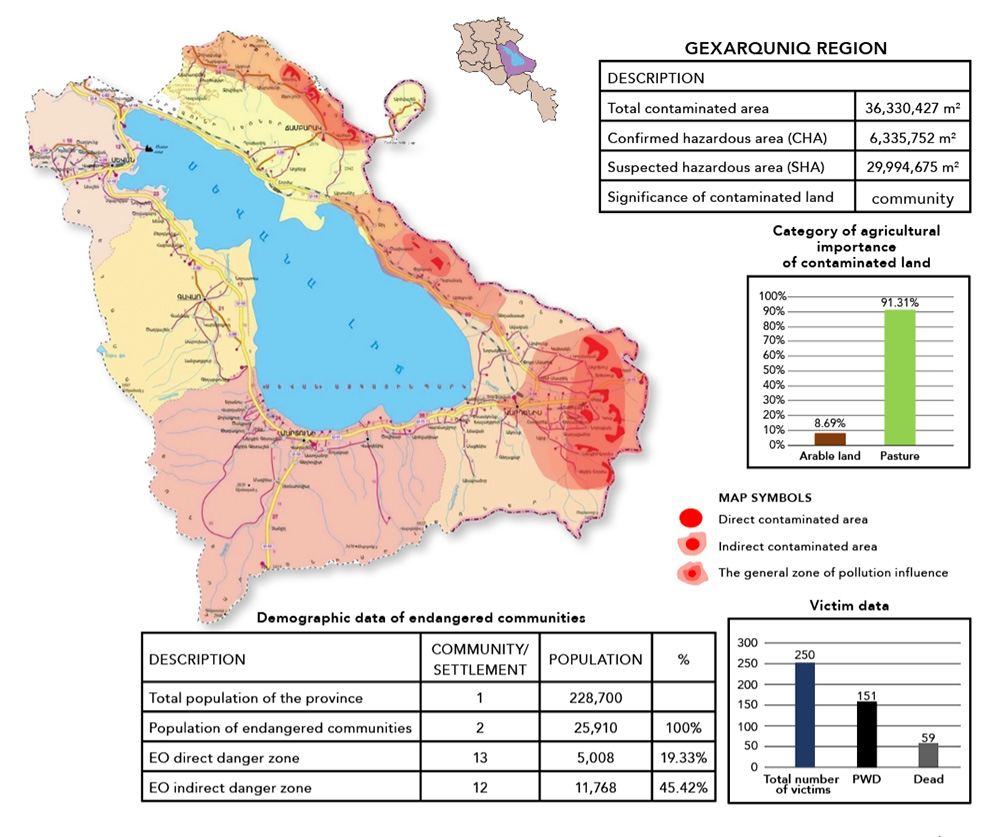
Stage 2: Assessment of Socioeconomic, Behavioral, and Environmental Impacts
Stage two includes socioeconomic impact analyses, including the identification of food security components, assessment of behavioral change, and activities to eliminate the impact of landmines and ERW on the environment. Following clearance in contaminated regions, the UN’s World Food Programme implemented socioeconomic activities in the Kechut community. Other examples include the construction of a reservoir in the Jermuk community, solar panels in the Vayots Dzor region, and the construction of waterlines in the Syunik region.
Stage 3: Victim Assistance
Stage three includes monitoring and updating landmine and ERW victim data, conducting needs assessments and priority setting, social reintegration of survivors, and assisting with individual primary problems such as health, everyday activities, and more. CHDE established a new database system, the VICTIM Information System (VIS), which includes gender, age, and need-disaggregated data.
Since 2022, in the framework of the Greening Mine Action initiative, the CHDE has implemented pilot projects in cooperation with several UN programs in Davit Bek and Vorotan settlements, Syunik region, Sotk and Geghamasar settlements, Gegharkunik region, Jermuk and Kechut settlements, and Vayots Dzor region. As a result, an analytical-operational program on the socioeconomic impact of contaminated areas was created.
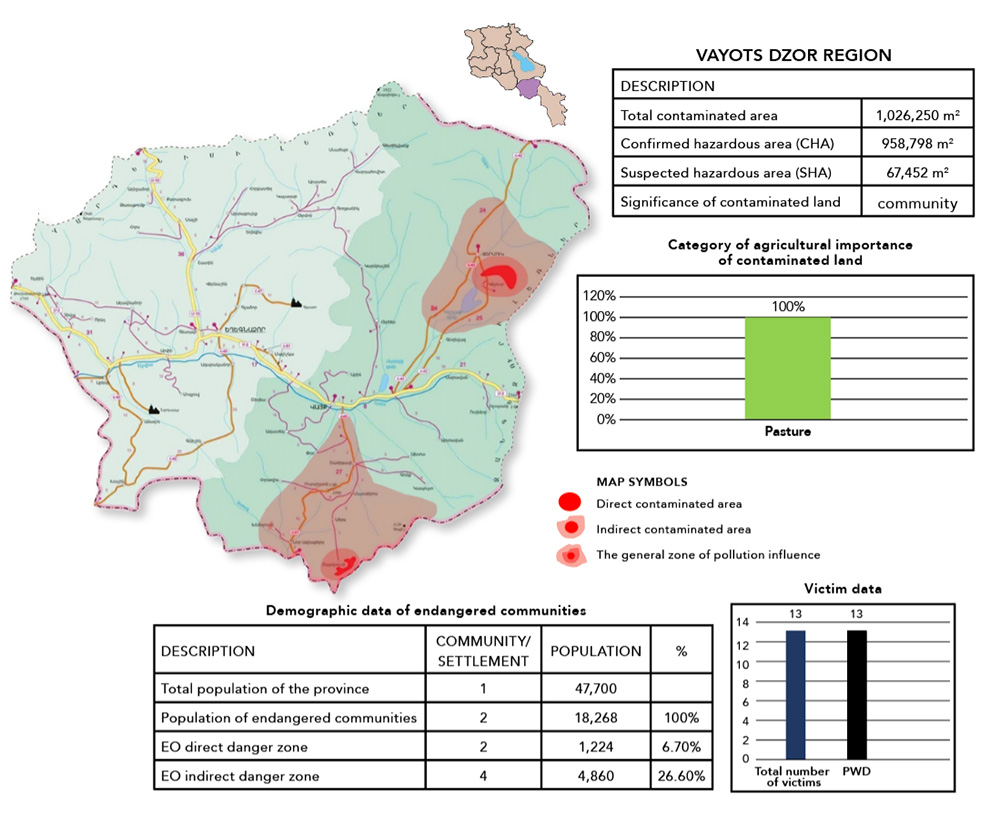
A number of activities have been implemented within this framework. These have included conducting clearance operations according to the “do no harm” principle and providing “Green Label” certification to cleared areas, implementing economic projects such as irrigation systems, greenhouse farming, and grassland restoration, expanding explosive risk education among schoolchildren and teachers, and expanding targeted social programs to support survivors and their family members.
As a result of Greening Mine Action, new links of cooperation have been established and strengthened between state and local self-governing authorities in Armenia and international institutions, preparing for the full and effective implementation of international humanitarian programs in Armenia.
Stable Economic Development of Armenia
To ensure its effective duration, significant importance is attached to the dynamic and systematic development of CHDE capacities. It also includes formal and informal learning, cooperation with international organizations, and forming a network of partnerships while organizing and implementing mine action activities.
The Advisory Group, established in 2023, consists of representatives from national and international organizations, UN offices operating in Armenia, the Geneva International Centre for Humanitarian Demining, and other organizations. This Advisory Group supports the CHDE and provides consultation on solving the most important issues in applying and introducing the latest tools and technologies in mine action. Furthermore, the Advisory Group supports the CHDE and other stakeholders with non-binding strategic advice, professional experience, knowledge, and invaluable contacts.
The objective of the CHDE is long-term capacity development for effective mine action activities in Armenia, aimed at clearing contaminated land to ensure civilians can move freely, succeed economically, and live safely in their communities. While the CHDE has laid the groundwork through surveys and mine action operations, the challenge remains in translating these initial successes into sustainable, enduring socioeconomic and environmental benefits for individuals, communities, and the country as a whole.
See endnotes below.
 Vaghinak Sargsyan is the Director of the Center for Humanitarian Demining and Expertise state non-commercial organization (CHDE SNCO). Mr. Sargsyan served in the Armed Forces of the Republic of Armenia, holding a number of positions, and is a Reserve Colonel. In addition to his work with the CHDE, he is a master of sports and was awarded the title of Honored Coach of the Republic of Armenia. http://www.chde.am/
Vaghinak Sargsyan is the Director of the Center for Humanitarian Demining and Expertise state non-commercial organization (CHDE SNCO). Mr. Sargsyan served in the Armed Forces of the Republic of Armenia, holding a number of positions, and is a Reserve Colonel. In addition to his work with the CHDE, he is a master of sports and was awarded the title of Honored Coach of the Republic of Armenia. http://www.chde.am/

